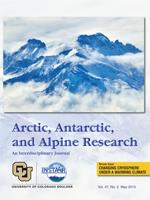In permafrost terrains, the frozen-unfrozen boundary, located at the base of the active layer, is a prominent ground-penetrating radar (GPR) target and is typically used to retrieve active layer thickness. Less attention has been given to the capability of the GPR in detecting structures within the active layer. In this paper, using 500 MHz GPR data from a thermokarst site in the Arctic Coastal Plain, we demonstrate that GPR can retrieve, when present, the internal stratigraphy of the thawed layer. We recognized two types of thermokarst-related microtopographic units: dry-and-uniform peaty hummocks with a thin (∼30 cm) active layer and inter-hummock depressions with a thicker (∼60 cm) active layer characterized by two different layers—a surface peat layer on top of silt confirmed by test pits. Radar wave velocity analysis, done with a common-midpoint survey, suggests a contrast in volumetric water content (87% and 45% for the upper and lower layers, respectively). The subsurface radar wave velocity suggests that the porous peat layer contains more water (87% by volume) than the underlying silt layer (45% by volume), resulting in a strong dielectric contrast and a strong radar reflection. This study demonstrates the usefulness of GPR to measure the thickness and properties of the surface organic layer in permafrost regions.
How to translate text using browser tools
1 May 2015
Active Layer Stratigraphy and Organic Layer Thickness at a Thermokarst Site in Arctic Alaska Identified Using Ground Penetrating Radar
Alessio Gusmeroli,
Lin Liu,
Kevin Schaefer,
Tingjun Zhang,
Timothy Schaefer,
Guido Grosse





